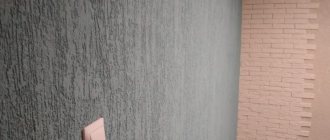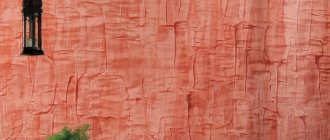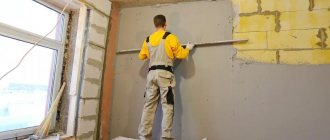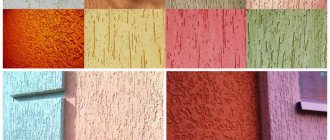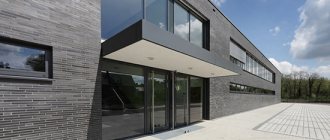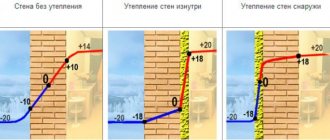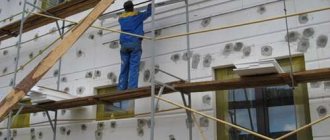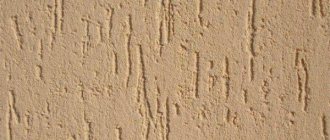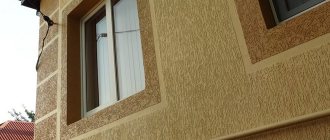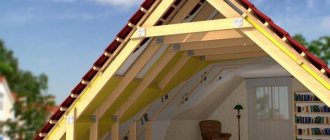“Bark beetle” is one of the types of finishing plaster. To apply it, a special heterogeneous mixture is used - viscous, with an admixture of solid components. "Bark beetle" is used to decorate external and internal walls. The advantages of this material are:
- simplicity and speed of application,
- practicality,
- durability,
- aesthetic appeal.
Bark beetle plaster is resistant to high humidity. It does not allow water to pass through, protecting building structures from getting wet. Another obvious advantage is the appearance.
When applied correctly, the result is a stunning finish that has excellent durability.
If you are thinking of using some other material instead of bark beetle, then you can see a list of modern materials, their advantages and disadvantages in our article: modern materials for finishing walls inside the house.
Composition and properties of bark beetle plaster
The bark beetle can be purchased dry or prepared. Mineral or gypsum dry mixture with cement binders is diluted with water. Used indoors and outdoors. It has high hardness and a tendency to crack. Cannot be used where ground vibrations are possible (near railway tracks, in seismically unstable places).
Acrylic bark beetle mixture. Sold ready-made, high quality, elastic, with a wide color palette. Acrylic resins are characterized by increased flammability, so they contain fire retardants. Cannot be used where there is an open fire nearby.
Silicone or silicate-silicone composition is only white. The highest quality and durable plaster. One minus - expensive. Very plastic, tinted before application.
Types of facade putties
By purpose
- Starting – used for preliminary leveling of the surface. Its peculiarity is that, unlike finishing putty, it hardens very quickly and it will be difficult to correct unevenness.
- Finishing – used for final leveling of ceilings and walls. After additional processing, you get a perfectly smooth and even surface.
Facade putty: finishing putty for exterior work.
Based on
- Cement – used for finishing premises outdoors or in rooms with high air humidity. With its help you can level the facades of rooms and walls in bathrooms.
- Gypsum - used only in dry rooms. Otherwise, under the influence of high humidity it is destroyed.
- Acrylic - used to level the surface.
Texture of bark beetle plaster
On the surface plastered using the “Bark Beetle” method there are small depressions, similar to the surface of a tree eaten away by a bark beetle. This voluminous texture looks very unusual in one or two colors. It is created using a special composition and application of material.
The ready-made or dry mixture includes marble chips of fraction 1 – 3.5 mm. The larger the pebbles, the larger and deeper the bark beetle’s furrows become. Their shape and direction depend on rubbing.
It is possible to form the following textures:
- Rain (straight or diagonal). To create direct rain, strictly vertical movements are made with a plastic trowel - a grater intended for rubbing; for diagonal rain - diagonally.
- Carpet: by alternating vertical and horizontal movements with a trowel. The furrows are arranged in blurred squares, similar to the weave of a carpet.
- The “Lamb” pattern is obtained by making circular, arched movements with a grater.
- A surface with the texture of balsa wood is obtained by rubbing it with a foam trowel using rotating, circular strokes of the hand.
Preparatory process.
If you want plaster that retains its original appearance for a long time, you need to know how to make bark beetle plaster with your own hands and at the same time with high quality. First you need to diligently prepare the base by cleaning it and plastering it as follows. The process goes like this:
- First, all possible remnants of the previous coating are removed, cleaned of dirt and grease stains. If necessary, the wall is leveled using sand-cement raw materials.
- If bark beetle plaster is applied in a place where the moisture level is constantly elevated, then the wall is treated with a specialized antifungal solution.
- Any gaps are cut out and treated with gypsum putty.
- If you apply bark beetle plaster indoors with your own hands, know that the minimum thickness should be 2 cm, after which grouting is carried out. When application is carried out on external coverings or walls that are plastered with a mixture of lime and cement, no primer is needed. It is enough to thoroughly moisten the surface with plain water.
- The walls must be completely cleaned, degreased and leveled before application.
When all the above requirements are met, you can prepare a decorative solution.
Bark beetle base
The basis for bark beetle plaster can be different: cement, brick, gypsum wall finishing. Many people insulate their houses with polystyrene foam, which is covered with a layer of putty under the plaster.
A reinforcing mesh should be installed over the foam plastic underneath the bark beetle.
- One rule is useful: if you are planning significant work on finishing the house (foam insulation, putty, plaster), you need to think through everything as carefully as possible in advance, use materials of the same brand.
- This is also provided for by the companies themselves, which produce products that combine well with each other. It is also important to immediately decide on the style and color of the finish, so that you do not have to putty, replaster, and one color does not break through another.
On large areas of finishing, especially in bright lighting inside or outside the building, errors and miscalculations are very noticeable.
Features of facade coating
For finishing external walls, special requirements are imposed on materials. These objects are subject to increased exposure to natural factors, such as:
- temperature changes;
- precipitation;
- solar ultraviolet.
Bark beetle plaster is a moisture-resistant material. But in the cold season, precipitation is not only a frequent occurrence, it also takes longer to dry. Temperature changes can affect the density of the material, and bright sunlight causes color fading. That is why for facade work it is important to strictly follow the finishing application technology. You should also only use mixtures intended for outdoor use.
For facade work, mixtures with large fractions are produced - 1.5 mm or more. The packaging should indicate that this product is suitable for outdoor use.
When decorating external walls with “bark beetle”, technologists recommend making a layer of external insulation. This will not only help keep the house warm, but will also shift the dew point. This move will reduce the likelihood of moisture accumulation and subsequent mold formation inside the structure.
Before you begin applying finishing plaster, you need to study the scope of work to find out whether additional processes are needed. This could be dismantling drainpipes, an outdoor air conditioner unit, and similar tasks. This will allow you to calculate the working time and determine in what portions to knead the mixture.
If it rained the day before, you should wait until the walls are completely dry. In this case, it is better to delay the deadline than to get a poor-quality result.
All preparatory work is carried out before the start of mixing in order to make the application of the “Bark Beetle” as effective as possible. Perforated corners are installed at the corners of the building - they are pressed against the wall and covered with a layer of plaster. This helps maintain even corners when decorating the building.
Primer before applying bark beetle plaster
The primer used is the same brand as the plaster. It is important to immediately determine which mixture will be used. The main importance is its appearance and quality: for internal or external work; composition of the plaster, coarse-grained or fine-grained (the appearance and pattern depend on this); color.
You can choose products of a certain brand, but the brand, in this case, does not matter much. Unless it will cost more than similar, equally high-quality mixtures from other manufacturers.
- Experts recommend priming surfaces with strengthening compounds containing quartz sand.
- Penetrating deep into the surface of the base, these liquids greatly increase the adhesion and water resistance of the coating.
- Such protection, increasing the strength of the base material, will prevent moisture penetration, peeling, peeling of layers, and prevent the development of mold.
There are solid bases for plaster and dust-forming ones. It is enough to treat hard ones with a primer once, but you will have to go over dust-forming ones twice. The weather must be warm, dry.
You can quickly prime with a roller or a wide brush. The primer must dry well. This will take up to 6 hours. If the walls are concrete or covered with cement-sand plaster, they do not need to be primed, but should be thoroughly wetted with water an hour before applying the Bark Beetle.
What to pay attention to
When considering the question of how to work with bark beetle, you first need to determine the composition that is ideal for certain conditions. If this is an external finish, you need to choose one that will be resistant to direct sunlight and mechanical damage.
Almost any type is suitable for interior decoration, the main thing is that the style matches the main design of the interior.
Preparation of the solution
After this, you can prepare the mixture for plastering. The finished product usually has a homogeneous mass, but the composition includes marble chips. Pebbles, even if they are the smallest, tend to sink to the bottom, so the finished mixture also needs to be mixed well, using a drill with an attachment.
The nozzle must be immersed deep into the bucket so that the mixture does not draw in air bubbles. Stir slowly, gently scrolling along the entire bottom of the container.
- The finished plaster and the dry mortar prepared from it must be worked as quickly as possible.
- Dilute the dry mixture a little at a time, only for one batch.
- Subsequently, adding water to the finished or diluted mixture is strictly prohibited.
It is important to understand this well and not try to revive a solution that has been standing for some time in order to save money. Otherwise, time will be wasted, and the appearance of the facade will be hopelessly damaged.
Conclusion
Bark beetle is a good solution for decorating walls, which is reliable, and you can also apply it yourself. The video in this article will show the important points of the workflow clearly, so that you understand it even better and can cope with the work without any problems. If you still have questions, then do not hesitate to write them in the comments under this review, we will analyze each of them.
Did you like the article? Subscribe to our Yandex.Zen channel
November 7, 2016
Construction Chemicals, Plaster and Wall Putty
If you want to express gratitude, add a clarification or objection, or ask the author something, add a comment or say thank you!
Application of bark beetle
Bark beetle should be applied in dry, warm weather. You should try to choose a day or time that is not very hot, because rapid drying will interfere with work, and cracks may also form.
Simply stir the finished mixture, carefully pour the dry mixture into water, mix well with a drill and mixer, let stand for 5 to 10 minutes, stir again and apply in a thin layer. Remove excess liquid solution from the wall into another container. Their reuse is impossible due to the lack of crumbs.
- An equal, even layer is created with a 300 mm metal trowel.
- Excessive amount of plaster is collected with a trowel and a 100 mm wide spatula.
- The thickness of the layer depends on the size of the marble chips in the mixture.
- This is approximately 1-3.5 mm. After application, allow to dry for about 20 minutes.
- The plaster should not shine or stick; then, by rubbing, a pattern is created.
Although the finished coating takes 30-40 minutes. seems dry, for complete readiness it should take at least a day before painting.
What tools may be needed.
For any construction manipulations, you must have specialized tools, the list of which is given below:
- Bucket, plastic grater, sprayer.
- Drill equipped with a mixer attachment.
- A spatula or construction spatula for applying raw materials.
- A roller and a container under it to apply the primer liquid.
In order for the bark beetle plaster to lay down easily, you definitely need to stock up on similar construction attributes. For visual completeness and aesthetics, do-it-yourself bark beetle plaster is leveled with a spatula.
Painting bark beetle plaster
Initially, it is recommended to tint the primer to match the tone of the plaster, which will create a more saturated color; areas with a thin layer, which still appear, will not show through, even with very careful application of the external finishing coat.
You can add dye to the finished acrylic or silicone mixture. It is necessary to dose out the amount very carefully, and also rub it well so that there are no lumps or clots of paint left.
- It is not recommended to tint dry mixtures when mixing. You need to paint already dried plaster with special facade paints no less than 24 hours after application.
- The first layer is applied with a wide brush or long-haired roller. To obtain a beautiful two-color bark beetle, the top layer is carefully painted over with a velor roller with very short pile, which is slightly dipped in paint so as not to paint over the furrows.
- Carefully done painting of the bark beetle looks excellent. The painted surface must be allowed to dry and covered with 1-2 layers of varnish.
“Bark beetle” plaster is light; protects well from cold and noise; easy to apply; hides surface defects; durable; resistant to fungi; washes well; environmentally friendly, does not fade under the sun.
Difficulty can arise from color selection and repairs in case of damage. Compared to the numerous advantages, this is a small drawback that does not affect the popularity of a beautiful and practical material.
Advantages of facade putty
- To work with this finishing material you do not need special tools. Standard metal, plastic or rubber construction spatulas of appropriate width are sufficient;
- After applying the putty to the surface, it dries quickly and does not form cracks;
This finish dries quickly.
- With its help, you can create a structured or smooth durable surface layer, which, if necessary, can be sanded with a conventional abrasive, for example, sandpaper;
- Harmless and environmentally friendly material that does not emit any odor during operation.
Photo of ideal wall finishing with bark beetle plaster
Results
Many country houses have terraces and balconies in their design. It is advisable that they be plastered in one texture, but you can use several shades when decorating. Thanks to this, every detail will be emphasized. The cladding option in beige and light brown looks interesting. Make the balcony and upper floor light, and the first floor a little darker. In this case, a large staircase with carved railings will serve as an addition.
Share the post “Finishing the facade with bark beetle for a private house: Pros and cons + Photos and Videos, instructions” by copying the link: https://kaksdelatsvoimirukami.ru/otdelka-fasada-koroedom-dlya-chastnogo-doma-plyusy-i-minusy-foto -i-video-instrukcii/
Use in interior and exterior decoration (on the facade)
The possibilities for using this material are almost endless. The mixture adheres well to bricks, concrete, cement plaster, plasterboard, polystyrene boards and all types of moisture-resistant plywood. The mixture can even be used to finish sandwich panels.
The bark beetle is widely used not only in Russia, but also abroad. Versatile material suitable for indoor and outdoor use. The decorative mixture can be used for finishing both public and private buildings. Even when using strict tones of the mixture, the façade of the building looks bright and attractive.
The characteristics of the material explain why this modern finish is beneficial: bark beetle based on silicone and acrylic binders provides high resistance to weathering and good vapor permeability.
Thanks to excellent adhesion to the facade, even application and skillful selection of composition, you can get many interesting shades and textures. The bark beetle is well suited for decorating the interior of new buildings and even for the restoration of old premises.
